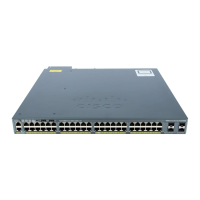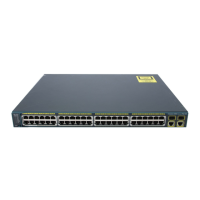Port Aggregation Protocol
The Port Aggregation Protocol (PAgP) is a Cisco-proprietary protocol that can be run only on Cisco switches
and on those switches licensed by vendors to support PAgP. PAgP facilitates the automatic creation of
EtherChannels by exchanging PAgP packets between Ethernet ports. PAgP can be enabled on cross-stack
EtherChannels.
By using PAgP, the switch or switch stack learns the identity of partners capable of supporting PAgP and the
capabilities of each port. It then dynamically groups similarly configured ports (on a single switch in the stack)
into a single logical link (channel or aggregate port). Similarly configured ports are grouped based on hardware,
administrative, and port parameter constraints. For example, PAgP groups the ports with the same speed,
duplex mode, native VLAN, VLAN range, and trunking status and type. After grouping the links into an
EtherChannel, PAgP adds the group to the spanning tree as a single switch port.
PAgP Modes
PAgP modes specify whether a port can send PAgP packets, which start PAgP negotiations, or only respond
to PAgP packets received.
Table 15: EtherChannel PAgP Modes
DescriptionMode
Places a port into a passive negotiating state, in which the port responds to PAgP packets
it receives but does not start PAgP packet negotiation. This setting minimizes the
transmission of PAgP packets.
This mode is not supported when the EtherChannel members are from different switches
in the switch stack (cross-stack EtherChannel).
auto
Places a port into an active negotiating state, in which the port starts negotiations with other
ports by sending PAgP packets. This mode is not supported when the EtherChannel members
are from different switches in the switch stack (cross-stack EtherChannel).
desirable
Switch ports exchange PAgP packets only with partner ports configured in the auto or desirable modes. Ports
configured in the on mode do not exchange PAgP packets.
Both the auto and desirable modes enable ports to negotiate with partner ports to form an EtherChannel based
on criteria such as port speed. and for Layer 2 EtherChannels, based on trunk state and VLAN numbers.
Ports can form an EtherChannel when they are in different PAgP modes as long as the modes are compatible.
For example:
•
A port in the desirable mode can form an EtherChannel with another port that is in the desirable or
auto mode.
•
A port in the auto mode can form an EtherChannel with another port in the desirable mode.
A port in the auto mode cannot form an EtherChannel with another port that is also in the auto mode because
neither port starts PAgP negotiation.
Catalyst 2960-XR Switch Layer 2 Configuration Guide, Cisco IOS Release 15.0(2)EX1
OL-29424-01 111
Configuring EtherChannels
Port Aggregation Protocol

